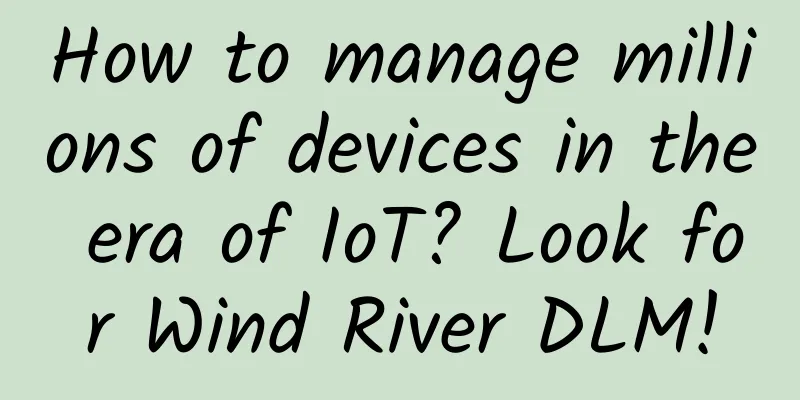What is the difference between the upcoming IPv6 and IPv4? This article will help you understand it clearly!

|
What is the difference between the upcoming IPv6 and IPv4? This article will help you understand it clearly! Due to the rapid development and popularization of the Internet, the original IPV4 address can no longer meet the needs of network users. Although NAT can alleviate the exhaustion of IPV4 addresses, NAT destroys the openness, transparency and end-to-end characteristics of the network environment. Therefore, the IPV6 address protocol came into being. In the near future, IPv6 addresses must be enabled!
Background of the emergence of IPV6 IPv4 has only about 4.29 billion addresses, but with the development of society, the number of devices that need to connect to the Internet has far exceeded this number.
IPv6 is imperative Advantages of IPV6 1. Larger address space: 128-bit address space can accommodate everyone on the planet 2. No NAT required: ensuring end-to-end communication 3. No broadcast address: including unicast, multicast, and anycast 4. Support mobility and security: Helps ensure compliance with mobile IP and IPsec standards 5. Simpler messages improve router efficiency 6. Interface identification: from the data link layer of the interface New Features of IPV6 1. Multiple addresses per interface 2. Link-local address: When exchanging routing updates, IGP uses the link-local address as the next hop address 3. Stateless autoconfiguration: An IPV6 device is assigned a unique link-local IPV6 address based on itself 4. Addressing that is independent or not independent of the provider IPV6 Address 1. An IPv6 address consists of 128 bits, which are represented by eight 16-bit segments. Each 16-bit segment is represented by a hexadecimal number, that is, four hexadecimal digits form a group, separated by colons. 2. The format is: x:x:x:x:x:x:x:x:xx represents 4 hexadecimal digits, for example: 2035:0001:2BC5:0000:0000:087C:0000:000A 3. The IPv6 address consists of two parts: prefix + local identifier 4. Prefix: Add a slash / after the IPV6 address, followed by a decimal number to identify how many bits of the starting bit of an IPV6 address are prefix bits. Generally, the prefix is 64 bits, such as: 3ffe:1994:100:a::/64 5. Interface ID: The interface ID is directly derived from the data link layer address of the interface. The ID is globally unique. It is 64 bits long and is dynamically created based on the MAC address. 6. Special IPV6 addresses are as follows:
IPV6 address abbreviation rules: 1. In a field consisting of 4 hexadecimal digits, the leading 0 can be omitted; for example: 09C0=9C0 0000=0 2. In each address, a pair of colons (::) can be used to represent any number of consecutive 0s; for example: ff02:0000:0000:0000:0000:0000:0000:0000:0005=ff02::5 Note: Only one pair of colons can appear in an address, otherwise the address cannot be uniquely determined. IPV6 address type
Global unicast address format: The network portion provides the location of a device on the downlink dedicated data link, and the host portion provides the identification of the device on this data link. The 16-bit subnet ID field can provide 65536 (216) different subnets
Local unicast address: An address whose usage scope is limited to a single link. The uniqueness is only valid on the link where it is located. The same address may also exist on another link, so this address is not routable outside the link where it is located. The starting 10 bits of the link-local unicast address are 1111111010 (FE80::/10) Configuring just a global unicast address will also create a link-local address (EUI-64) on the interface.
Description: Mark bit: The first 3 bits are reserved as 0, the 4th bit: 0-permanent recognized address; 1-temporary address Range: including: node local-0X1, link local-0X2, region local-0X5, organization local-0X8, global-0XE, reserved-0XF 0X0 Group ID: The first 80 bits are set to 0, and only the last 32 bits are used Commonly recognized IPv6 multicast addresses: all belong to the permanent link-local scope;
|
<<: 5G will change society in the future: eight application scenarios
>>: Private wireless networks provide secure solutions for digital transformation
Recommend
Ethernet VS PON network: Which one is more suitable for enterprise campuses?
The trend of optical fiber replacing copper fiber...
New 5G LAN technology advances QoS across the enterprise
As enterprises integrate 5G technology into their...
Mastering Internet sovereignty in the IPv6 era is a war we cannot afford to lose
30 seconds quick read For the Chinese Internet, t...
China Mobile's operating revenue in the first quarter of 2021 was 198.4 billion yuan, a year-on-year increase of 9.5%
[[394900]] China Mobile today released its main o...
Edge computing is the key to unlocking 5G’s true potential
[[434589]] The hype for 5G has been an increasing...
The difference between TCP and UDP and detailed explanation of flow control, congestion control, fast retransmission, and fast recovery algorithms
[[413351]] Differences between UDP and TCP In the...
Three lives and all things go hand in hand with wisdom | Beijing Unicom and Huawei jointly release the results of 5G Capital innovation project
[Shanghai, China, November 12, 2020] During the 2...
How to deal with the nightmare of network outage
Reducing network outages is becoming an increasin...
Summary of the State Council Information Office press conference, involving 5G, chips, etc.
[[423758]] On the morning of September 13, the St...
DiyVM upgrade KVM, Japan/US/Hong Kong CN2 line 2G memory monthly payment from 50 yuan
I have shared DiyVM many times in my blog. It is ...
Edge computing is the driving force for enterprise IT transformation in the next decade
According to forecasts, the number of 5G subscrib...
Seven IT salary and hiring trends for 2018
The good times for tech workers will continue int...
5G development enters its fourth year, and innovation is the key to development
On June 6, 2019, the Ministry of Industry and Inf...
Ms. Meng: Being brave is not about not being afraid, but about holding on to the ideals in your heart.
Last night, a letter from a Japanese person was s...
Cutover failed, resulting in 3/4/5G network communication failure
[[429420]] A cutover and replacement by Japanese ...









